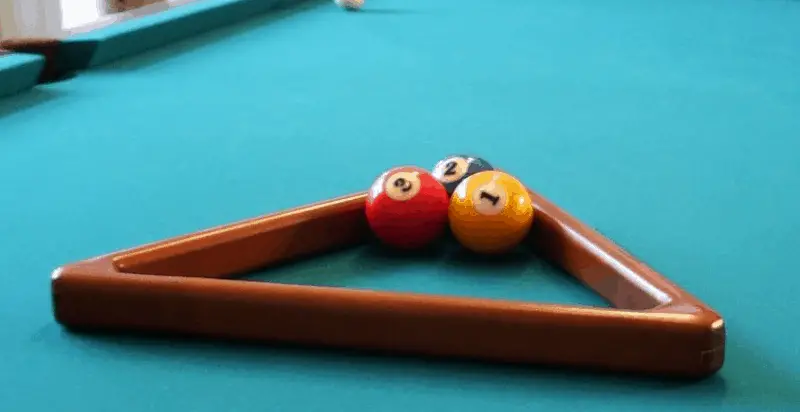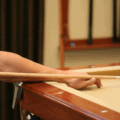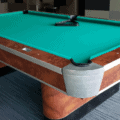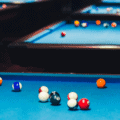Everyone loves a game of 8-ball or 9-ball pool, but 3-ball is an inventive and increasingly popular rapid-fire alternative. It’s a game that has only a few strict or official rules, but is developing strong traditions by which it can be played. In several ways, it’s like no other kind of pool you’ll ever have played in your life.

So how do you play 3-ball pool?
Chalk your cue and step this way.
Set Up
3-ball pool is played more like golf than like traditional 8-ball.
Whereas in traditional 8-ball, there are only two players in a game, that’s not the case with 3-ball, which can have lots of players in a row.
Also, each player has a table entirely to themselves for the time it takes them to complete their part of each match – or ‘innings’ as it’s called, borrowing from the game of cricket.
The set up is very simple. There are three object balls and a cue ball.
The three object balls are racked up as a small pyramid, two balls next to one another horizontally, and the third above them, as in the top of an 8-ball pyramid – and in the same position on the table.
While these object balls can be any balls chosen at random, a convention is growing that they be the 1, 2 and 3 balls.
Gameplay
The cue ball is used to strike and pot the object balls. The players will start with the cue ball behind the head string, but can place it anywhere behind that string for their favored approach to the break.
Player 1 breaks and pots all three balls, uninterrupted by their opponent. A note is made of the number of shots it took Player 1 to pot the three balls.
The balls are re-racked and Player 2 then does the same thing, potting the three balls in the smallest possible number of shots.
Structure
Points are allocated based on the number of shots a player takes, one point per shot, and one additional point for any foul they make.
The player who amasses the lowest point score wins the ‘innings.’
Usually, the number of innings in a round will be decided before the game begins. Best of 3 and best of 5 are popular versions. To win a round of best of 3, you have to get the lowest number of shots twice in three innings. In a round of best of five, you have to use the smallest number of shots three times in five innings.
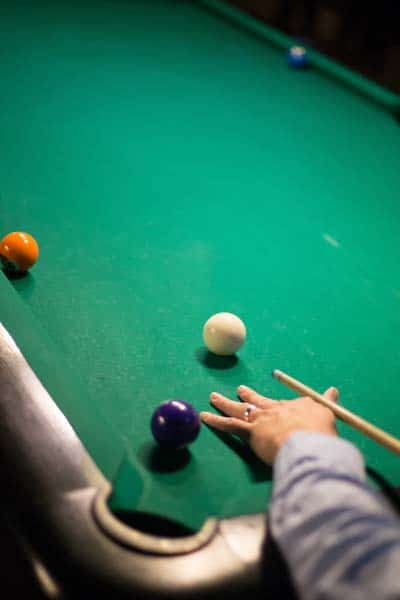
To speed the game up even more, many 3-ball games are played with a maximum shot number. If you take, say, five shots to pot the three balls, you are out, and the next player in line takes over. The balls are re-racked for each new player.
Any professional tournament of 3-ball may consist of many multi-innings rounds, played either back to back or spread across a period of time from hours, even to weeks, as various innings and rounds are played between different players.
Scoring
Each player scores a point for each shot they take, irrespective of whether they pot a ball, or how many balls they pot on a single shot. For instance, some experienced 3-ball players will be able to pot a ball during their break. They still get a point for the shot that broke. If they happen to pot two or even all three balls on the break, they still get the single point.
That logically means that the Holy Grail of 3-ball scores is 1 point per innings. Every extra shot it takes a player to pot the remaining balls adds another point to their total, up to and including the pre-agreed maximum, after which number they have to drop out.
They also get an extra point added to their total for every foul they make. This makes 3-ball one of the most precision-rewarding variants of billiards.
Fouls
Players amass points both by taking legitimate shots and by incurring fouls. Given the rapid-fire, point-dependent nature of the game, it’s more important to be aware of the fouls in 3-ball than in almost any other variant of billiards. Here’s a quick run-down of what not to do if you want to win innings, rounds and ultimately tournaments of 3-ball.
- Causing the cue ball to leave the table
- Double hitting the cue ball. Double hitting occurs when you touch the cue ball after the initial contact is made
- Push shots. These are exactly what they claim to be – when the cue actively pushes the cue ball along the table, rather than making a single clean contact with it
- Any illegal movement of the cue ball or the object balls. This can be made either by hands or by pushing with the end of the cue
- Any illegal jump shots. Illegal jump shots are defined in the general bylaws of pocket billiards. These include common scoop shots, which are shots by which players frequently jump balls by accident
Whenever a foul occurs, an extra point is added to the player’s score. In addition to which, when a foul is made, players will take the cue ball in hand and place it behind the head string, on the same side of the table as that from which they broke. While some players see this as rewarding the player who committed the foul, it can also be seen as a double-fault. The number of points they have goes up, and they have to remove the cue ball from any position of advantage for their next shot.
The Cut Off Point
The cut off point originated as a way of both speeding up innings of 3-ball, and to some extent, spicing them up too.
While many amateur or general players might not bother to enforce the cut off point, some will draw the line at the relatively reasonable 5-point level.
The more experienced the players though, the more likely they are both to enforce the cut off point, and to lower its level, some even going down as low as just three shots.
It’s a maneuver that totally changes the nature of the game, raising stakes, amplifying risks and creating the basis of a kind of handicap system, as in golf. If no innings is allowed to be more than five shots long, it allows less experienced players to go effectively two shots ‘over par,’ the equivalent of a golfing bogey.
On the other hand, more experienced players setting the cut off point at just three shots are effectively demanding that the table be played at par or better. They’re demanding that every shot played has to pot at least one ball. That amplifies the risk right from the beginning. Many experienced 3-ball players will be able to pot at least one ball on their break, but if that doesn’t happen, the pressure on their next two shots is magnified enormously.
Ties
The shortness of each innings and the fact that each player’s point score is individual to their innings leads to a higher likelihood of tied games. That likelihood is further intensified by the fact that there’s no single ball which, when potted, ends the game for both players.
So what happens if an innings or a round is tied?
If there are only two players, there’s an obvious ‘Rock, Paper, Scissors’ solution. They simply keep playing until there’s a winner. When there are more than two players in any innings, there’s a similar solution. Play continues in innings until players are forced out by hitting the cut off point or there’s a points difference between players, and the last player standing wins.
Related: Tips to Become a Better Pool Player
Winning
We’ve said that the player with the lowest number of points in an innings wins that innings, and in the case of best of 3 or best of 5 rounds, the player who achieves the lowest score in 2 or 3 innings respectively wins the round.
In terms of tournament play, there are two ways in which a player can be declared the winner. According to strict scoring, the winner will be the player who has the lowest total score over all the rounds of play. In looser scoring, the principle of the best of 3 innings holds true, and the winner is the player who wins the most rounds overall.
In tournaments, if there are ties – there are likely to be more than one, for the reasons we mentioned – a play off round is invoked between all the tied players. The round is then replayed if necessary until the players hit the cut off point or until there’s a clear points difference between them. Those with higher point-numbers than any remaining tied players drop out and the next play off is between only those players still tied.
Conclusion
The world is familiar with many variations of billiards, and America loves both 8-ball and 9-ball. But the speed, the excitement and the precision challenge of 3-ball is making it more and more popular. Pot balls fast and accurately, don’t make fouls, and avoid the cut off point, and you could be playing 3-ball with the best of them. Or you could just add a great new dimension to pool with your friends. Now you know how, give 3-ball a try today.
[no_toc]

I’m Lia and I love playing games. I started this site to share things with friends and they encouraged me to post more and now I’m trying to share things with the world – indoor and outdoor sports, and board and bar games. I write about things like Bocce, Croquet, Billiards, Darts and other fun ways to enjoy time with your friends and family!

